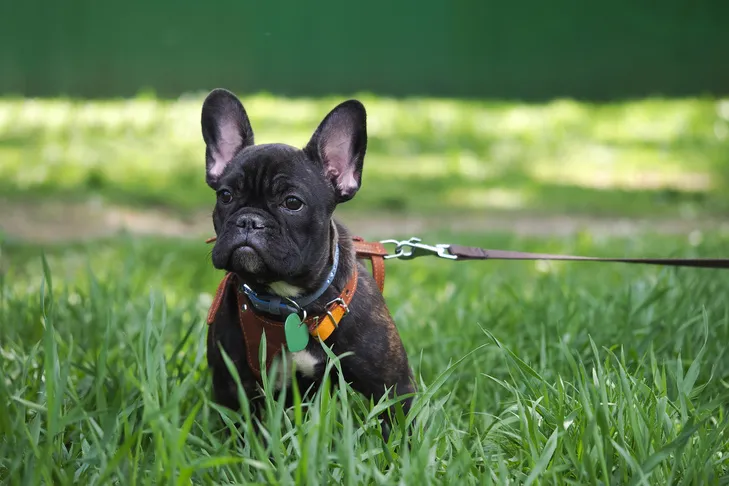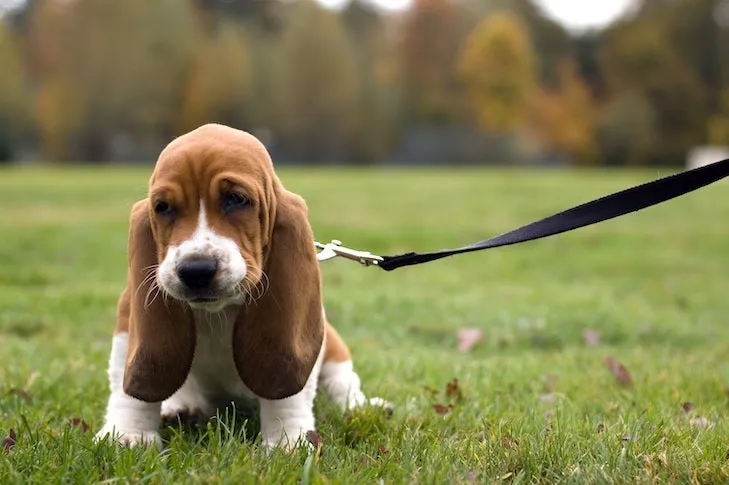Learning How To Train Your Puppy On Leash is a foundational skill for any dog owner. Many new puppy parents assume that dogs instinctively know how to walk politely beside them, but this crucial ability is developed through consistent training. A well-trained puppy on a leash ensures enjoyable walks for both of you, fosters a stronger bond, and sets the stage for more advanced training. Esteemed dog training expert and AKC Family Dog training and behavior columnist Kathy Santo shares invaluable insights to guide you through this process. Mastering loose-leash walking from an early age is vital for a well-behaved companion.
Laying the Foundation for Leash Training Success
Establishing a positive association with the leash and collar is the first step in teaching your puppy to walk on a leash. Follow these structured steps to build a solid foundation for all your future adventures.
Introducing the Collar, Harness, and Leash
Begin by familiarizing your puppy with wearing a collar or harness and a leash. For their first encounters, allow them to wear these items for short durations inside the house. During this time, engage them in playful activities and reward them with their favorite treats. The goal is for your puppy to associate collar-and-leash time with positive experiences, fun, and food. This positive reinforcement is key to preventing negative feelings about their walking gear.
Establishing a Reward Cue
Introduce a consistent sound cue that signals “food is coming” to your puppy. Some trainers opt for a clicker, while others use a verbal marker like “yes,” or even a specific tongue cluck. The method remains consistent: in a quiet, low-distraction environment, with your puppy wearing their leash and collar, make your chosen sound. The instant your puppy acknowledges the sound by turning towards you or making eye contact, reward them promptly with a treat. With several repetitions, you’ll observe your puppy not only looking at you but also eagerly approaching for the treat, connecting the cue with a positive outcome.
 Cute French Bulldog puppy on a leash learning proper walking in green grass, showcasing early leash training.
Cute French Bulldog puppy on a leash learning proper walking in green grass, showcasing early leash training.
Encouraging Your Puppy to Come to You
Once your puppy understands the reward cue, begin to incorporate movement. While your puppy is still wearing their leash and collar and making their way towards you after hearing the cue, take a few steps backward. Reward them generously with a treat once they reach you. Gradually extend this progression, so your puppy, upon hearing the cue, consistently comes to you and walks alongside you for a few paces. Remember that puppies have limited attention spans. Keep your training sessions brief and always end them on a high note, leaving your puppy eager for more rather than mentally exhausted. If you want to delve deeper into teaching your puppy to come reliably, exploring dedicated recall training resources can be very beneficial.
Practice Makes Perfect: Indoors to Outdoors
With the foundational steps in place, it’s time to expand your puppy’s leash training environment.
Practicing Inside
Now that your puppy understands the concept of coming to you with a leash on, practice walking a few steps in a room with minimal distractions. Simply feeling and seeing the leash will provide enough of a challenge at this stage. Continue to offer treats and praise as your puppy learns to follow you, building confidence and reinforcing good behavior in a controlled setting. This controlled environment is crucial for consolidating their understanding before facing the outside world.
Stepping Outside
Finally, you’re ready to introduce your puppy’s newly acquired skills to the great outdoors. This step presents new challenges, as the multitude of sounds, smells, and sights will naturally intrigue and potentially distract your puppy. Be patient and keep these initial outdoor walks short. Throughout your walk, maintain constant vigilance over your puppy. If you notice them preparing to lunge towards something or getting distracted, immediately use your cue sound and take a few steps away from the distraction. Reward them with a treat for redirecting their attention and following you. This proactive approach helps your puppy learn to focus on you even amidst external stimuli.
 Adorable Basset Hound puppy calmly sitting in lush grass while practicing outdoor leash training.
Adorable Basset Hound puppy calmly sitting in lush grass while practicing outdoor leash training.
Troubleshooting Common Leash Training Challenges
Even with a strong foundation, puppies may develop specific behaviors on leash as they mature, explore new environments, and encounter different distractions. Addressing these issues proactively is essential for enjoyable walks.
When Your Puppy Pulls
If your puppy begins to pull excessively in the opposite direction, adopt the “be a tree” technique. Stand completely still and refuse to move forward until your puppy loosens the leash and returns their attention to you. Avoid yanking, jerking, or dragging your dog along, as this can be counterproductive and uncomfortable. For puppies with a persistent pulling habit, alternative training tools such as front-hook harnesses or head halters can be effective in gently discouraging pulling behavior. For more advanced strategies to stop puppy pulling, specialized resources can offer further guidance.
Addressing Puppy Lunging
Should your puppy start lunging towards specific targets during walks—such as other dogs, cars, or skateboarders—it’s crucial to be proactive. Anticipate their reactions and try to redirect their attention with a treat before they have the chance to lunge. Increase the physical distance between your puppy and the trigger, giving them more space to remain calm. Stay alert and prepared, creating a buffer before the object of their frustration gets too close. While this behavior might be more prevalent in certain breeds like herding dogs, any puppy can be startled or overstimulated by unfamiliar or exciting elements in their environment.
Managing Excessive Barking on Leash
Some puppies develop a habit of barking at other dogs or passersby while on walks. This behavior can sometimes stem from insufficient mental and physical exercise. Ensure your puppy receives an appropriate amount of stimulation for their age and breed. If barking persists, employ a similar proactive strategy as you would for lunging. Create distance from the trigger and offer treats before they start to bark. Consistently doing so will teach your puppy to look to you for a reward every time they spot another dog, rather than reacting with barking.
Gradually, as your puppy’s leash manners improve, you can reduce the frequency of treats and the amount of troubleshooting required during your walks. However, it’s always a good practice to keep some treats on hand to randomly reinforce desirable leash-walking behavior, ensuring long-term success.
Acknowledgements
This guide incorporates valuable advice from renowned dog training expert Kathy Santo, a columnist for AKC Family Dog, and reflects the trusted guidance provided by the AKC GoodDog! Helpline, which offers professional, individualized training assistance.
